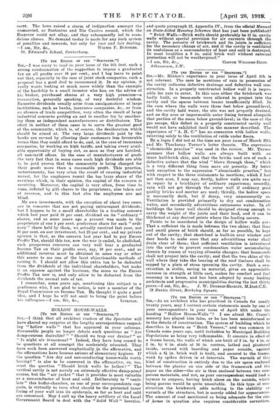[To ins Emma or ma " Semmes..7
Ste,—Mr. Hinton's experience in your issue of April 5th is not relevant. The case he mentions of rats in possession of the cavity indicates defective drainage and defective wall con- struction. In a properly constructed hollow wall it is impos. sible for rats to enter. In this case either the brickwork was badly built, or beam-ends were allowed to project, into the cavity and the spaces between beams insufficiently filled. In the case where the walls were three feet below ground-level, and the cavity held water, the site was not properly drained, and no dry area or impermeable outer lining formed alongside that portion of the room below ground-level; in the case of the gas escape, this defect in a properly constructed cavity wall would not have exhibited itself in the manner described. The experience of " A. H. C." has no connexion with hollow walls, referring solely to the ventilation of voids under floors.
By a lapse I did not at the time see your issue of March 29th and Mr. Thackeray Turner's letter therein. The expression "abominable practice" was used in the review. Mr. Turner assumes that hollow walls are always built with an inner half-brick skin, and that the bricks used are of such a defective nature that the wind " blows through them," which is a very different thing from mere air porosity. My letter took exception to the expression " abominable practice," but with respect to the three statements he mentions, which I had not then seen, I may say, firstly, hollow walls are quite easy to repair by a bricklayer of ordinary experience; secondly, rain will not get through the outer wall if ordinary good quality bricks and mortar are used; thirdly, the hollow space is necessarily dark, but if damp, very unnecessarily so. Ventilation is provided primarily to dry out condensation water, and secondarily adventitious extraneous water. In all
• buildings the inner wall should be designed strong enough to carry the weight of the joists and their load, and it can he thickened at any desired points where the loading occurs.
Points to be considered in the design of hollow walls are That a sufficient tie is made between the two skins; that lime and small pieces of brick should, as far as possible, be kept out of the cavity; that sheet-lead is built-in over window and door heads to make sure that any adventitious water shall drain clear of them; that sufficient ventilation is introduced into the cavity to prevent condensation water accumulating therein by reason of varying climatic changes; that beam-ends shall not project into the cavity; and that the two skins of the wall where they take the bearing of the roof timbers shall be capped by a plate of stone spanning the cavity. Such a con- struction is stable, saving in material, gives an appreciable increase in strength at little cost, makes for comfort and fuel economy in a house, and has been adopted by many leading architects and progressive municipalities during the last thirty






































 Previous page
Previous page